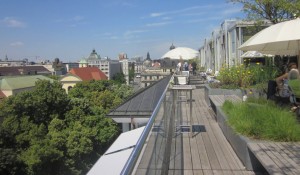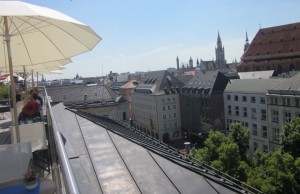Tag Archive
activity architecture art artist building Canada children city CostSaver downtown drive i-95 entertainment Europe event exhibit family festival Florida food fun historic History landmark local Museum music Nature New Zealand Ontario roadtrip sculpture Seattle show sights sightseeing tour tourist Trafalgar travel travelblogger view Washington Washington State water world
Cosmos Tour: Prague Vienna Budapest – Beloved Sisi, Empress Elisabeth
Just as we have our beloved famous Disney princesses, the Austro-Hungarian Empire had theirs – but she was for real. They call her by her nickname Sisi, and she was their Empress for 44 years.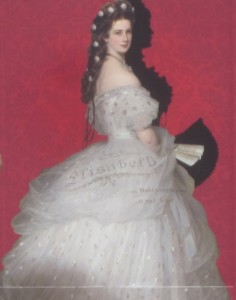
Their have been numerous movies, plays, operas, ballets, books and music about her in the German speaking world. It is probably the trilogy of romantic films about her life which starred a young Romy Schneider which made her a household name. She is so popular that the 3 movies are shown every Christmas on Austrian, German, Dutch, and French television.
Though her husband Emperor Franz Josef adored her, she felt stifled by Habsburg court life and traveled extensively whenever and wherever she could. She loved learning and spoke English, French, modern Greek and Hungarian. Her domineering mother-in-law made her life miserable and even took away her children to raise. Her first daughter died as a toddler and her beloved son Crown Prince Rudolph, heir to the throne, committed suicide along with his lover, and she never fully recovered from that loss.
Empress Elisabeth was vain and did not sit for any portraits after she was 32 and would not allow any more photographs, so that her public image would always remain of her youthful self. She was tall, and compulsively maintained the same low weight all through her life thru exercise (horsemanship, fencing, hiking) and fasting.
Her interest in politics had developed as she matured. She felt an intense emotional alliance with Hungary, and worked toward it gaining an equal footing with Austria. Elisabeth was an ideal mediator between the Magyars and the Emperor. She was a personal advocate for Hungarian Count Gyula Andrássy (he was a lifelong friend, and possibly her lover).
Finally, the Austro-Hungarian Compromise of 1867 created the double monarchy of Austro–Hungary. Andrássy was made the first Hungarian prime minister, and in return he saw that Franz Josef and Elisabeth were officially crowned King and Queen of Hungary.
Sisi was assassinated “by accident” in 1898 by Luigi Lucheni, who had planned to kill the Duke of Orleans, Pretender to France’s throne, but the Duke had left town. Despite warnings of possible assassination attempts Elisabeth, now age 60, traveled incognito to Geneva. She eschewed the protection which the Swiss government had offered and only promenaded with her lady-in-waiting.
You can visit many of her residences: her apartments in the Hofburg and the Schönbrunn Palaces in Vienna, the imperial villa in Ischl, the Achilleion in Corfu, and her summer residence in Gödöllő, Hungary.
These plaques, mounted in Vienna, tell some of her story:
Germany: Munich Hotel Bayerischer Hof
The Hotel Bayerischer Hof was opened in 1841 because King Ludwig I wished to have a comfortable place for his guests to stay. (What – no extra rooms in his gi-normous palace?). Today it is still a gorgeous 5-star hotel, but we think the best places are on the roof and in the basement.
Palais Keller, situated in the old salt cellar from the Middle Ages, is an inexpensive but delicious place to dine on traditional Bavarian food. Go down the stone steps to this bustling restaurant with waitresses sporting frilly aprons, carrying big mugs of Lowenbrau beer and wearing big smiles. The folkloric atmosphere only adds to the taste of the veal in cream sauce with spaetzle, potato salad, sauerkraut, bread dumplings, weiswursts and cheese wursts, along with pretzels with mustard.
After you’ve dined head for the roof, to the Blue Spa Bar & Lounge. Have a drink in the sky and take in the birds-eye view of all of Munich before you.
In 1897 Herrmann Volkhardt bought the hotel, and today Innegrit Volkhardt, the fourth generation, is the General Manager. It was bombed in WWII; Falk Volkhardt, the son of Hermann made an amazing discovery under the ruins of the destroyed hotel – the Spiegelsaal (Mirror Hall) had survived almost intact. In October 1945, this was where he opened the first restaurant in the centre of Munich after the war.
Germany: Munich Residenz
The Wittelsbach dynasty ruled the German territories of Bavaria from 1180 to 1918 – that’s 738 years, pretty impressive. Munich Residenz, their former royal palace, is located right in the center of Munich and very much open to the public. After 4 centuries of building it, the giant palace is made up of many styles: late Renaissance, Baroque, Rococo and Neo-Classicism.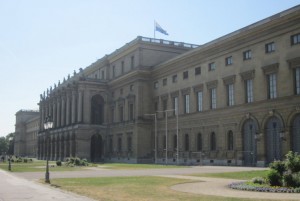
Though spartan on the outside, it is very opulent inside. You can tour it for its architecture, over-the-top room decor (130 rooms), and displays from the former royal collections. After WWII, the Cuvilliés Theatre was built into the Festsaalbau wing. You can also catch the Bavarian Radio Symphony Orchestra in Hercules Hall. In his time, Mozart performed in this palace.
The Treasury houses the jewels of the Wittelsbach dynasty and spans 1,000 years, from the early Middle Ages to Neo-classicism, and includes: crowns, swords, golden objects, rock crystal, ivory, goblets, icons, tableware and toiletries.
The palace suffered huge damages during WWII, but the curators managed to store furnishings, art and details of its architecture in mines. When you are wandering around the 10 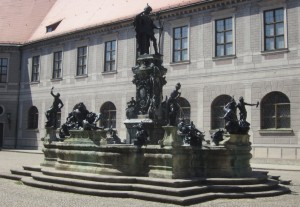 courtyards, see if you can find this fountain with statues of fire, water, earth and air on its corners.
courtyards, see if you can find this fountain with statues of fire, water, earth and air on its corners.
The Wittelsbach family’s head, since 1996, is Franz, Duke of Bavaria, and he still hangs out in Munich. During WWII, the Wittelsbachs were anti-Nazi and were arrested when Franz was 11. He spent time in several Nazi concentration camps. After the war, he studied at the University of Munich and became a collector of modern art. Some of his collection is on loan to the Pinakothek der Moderne Museum (see other post).

